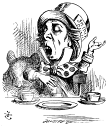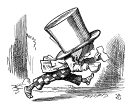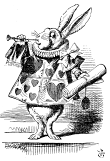Search us!
Search The Word Detective and our family of websites:
This is the easiest way to find a column on a particular word or phrase.
To search for a specific phrase, put it between quotation marks. (note: JavaScript must be turned on in your browser to view results.)
Ask a Question! Puzzled by Posh?
Confounded by Cattycorner?
Baffled by Balderdash?
Flummoxed by Flabbergast?
Perplexed by Pandemonium?
Nonplussed by... Nonplussed?
Annoyed by Alliteration?

Don't be shy!
Send in your question!
Columns from 1995 to 2006 are slowly being added to the above archives. For the moment, they can best be found by using the Search box at the top of this column.
 If you would like to be notified when each monthly update is posted here, sign up for our free email notification list.
If you would like to be notified when each monthly update is posted here, sign up for our free email notification list.
Trivia
All contents herein (except the illustrations, which are in the public domain) are Copyright © 1995-2020 Evan Morris & Kathy Wollard. Reproduction without written permission is prohibited, with the exception that teachers in public schools may duplicate and distribute the material here for classroom use.
Any typos found are yours to keep.
And remember, kids,
Semper Ubi Sub Ubi
|
Be right back! [Door slams; sound of car receding into distance.]
Dear Word Detective: I was recently reading a folk history, “Forgotten Towns of South Jersey,” in which the author refers to a 19th century preacher in his “long-tailed coat and dicer.” A coat I understand, but what is a “dicer?” An internet search turns up one reference, a turn-of-the-last-century newspaper feature about the discomfort of formal wear, again referring to the mysterious “coat and dicer.” Thinking about “dicer” made me realize how odd the whole “die-dice” group of words is. There is the verb “die,” to cease to live; the nouns “die,” the metal cutting tool (plural “dies”), and the gambling cube (plural “dice”(!)), the verb “dice,” to cut into cubes (which resemble dice). I hope you can define “dicer” and unravel the rest of the “die/dice” mess. O, what a tangled web we weave, when first we practice to die-sieve (sorry, couldn’t stop myself). — Sam Glasscock.
Uh huh, OK, no problemo. Before we begin, however, I think I’ll warm up with something a bit simpler and less stressful, like giving our cats a bath. All at once. Seriously, that’s seventeen, maybe forty-six questions you have there, and this is the Three Items or Fewer aisle. So I’ll give it a shot, but don’t blame me if the ice cream ends up in the dog food bag.
Perhaps it’s best to begin at the end, so to speak. The verb “to die,” meaning to join the choir invisible, pine for the fjords, or just plain “croak,” appeared in the 12th century, probably borrowed from the Old Norse “deyja” (to die), which came from an ancient Germanic root, the same one that gave us “dead” and “death.” English had words for “die” before then, of course, but we adopted “die” when they were abandoned in favor of euphemisms (although those old “die” words live on in our modern “starve,” “swelter” and “quell”).
The “die” used in games of chance (plural “dice”) and the “die” meaning “metal block used to cut or stamp” (plural “dies”) are actually the same word, rooted in the Latin verb “dare,” meaning “to give,” but also “to play.” We adapted “die,” in the 14th century, from the Old French “de,” the plural of which was “dez,” which became our weird plural for the spotted cubes, “dice.” The verb “to dice,” to cut into small cubes, did indeed come, also in the 14th century, from this gambling sort of “dice.” The machine-shop sense of “die” arose later, in the 17th century, and took the more conventional English plural form “dies.” This “die” reflects the “give” sense of the Latin verb, as the die gives a shape to the material stamped or cut.
And now, the envelope please. A “dicer” is a man’s hat, made of stiff silk or felt, not as tall as a top hat, but of similar shape (though the term is sometimes also applied to a derby). “Dicers” were popular in the 19th century, and the term is still used as slang for any sort of hat with a brim, including baseball caps.
During the same period, “dicer” was also slang for a gambler specializing in games involving dice. It’s possible that “dicer” as the name for hat owes something to its popularity among gamblers, but several sources I found indicate that the name comes from the hat’s perceived similarity in shape to the sort of small felt-lined cup used to shake the dice in games of chance. It’s also possible that such a stiff, deep hat made an excellent “dice cup” in a pinch.
But vim.com is taken, so don’t bother.
Dear Word Detective: Why does “vim” only exist with “vigor”? Can we change that? — Joe.
Well, you’re welcome to try. After all, language is a true democracy, a rare bird these days. Anyone can put a word or phrase to a vote simply by using it and convincing other folks to take it for a spin. That’s how, after all, we ended up with such creations as “ginormous” and the appending of “2.0” to all sorts of silly things (Web 2.0, Business 2.0, Clumping Cat Litter 2.0, et al.). So go for it — get out there and use “vim” by itself at every opportunity. I should warn you, however, that it’s much easier to launch a new usage than to sink an old one, so I wouldn’t waste time ranting against the “vim and vigor” pairing. Back in the early 18th century, Jonathan Swift, master satirist and author of Gulliver’s Travels, did his best to abolish a long list of words he disliked, including “mob,” “sham,” “banter,” bully” and “bubble.” As usual, the “mob” wasn’t listening.
While it’s true that “vim” is today almost always encountered bolted to “vigor” in the cliche “vim and vigor,” that’s apparently a relatively recent development. The Oxford English Dictionary (OED), in fact, doesn’t contain a single print citation for “vim and vigor,” although a Google search, as of today, produces more than 55,000 results. Judging from what I’ve found poking around in a number of places, “vim and vigor” seems to have become truly popular only in the late 19th century. The secret of the success of “vim and vigor” as a cliche is, of course, its alliteration, the repetition of that initial “v.”
It would have been difficult for “vim and vigor” to have been a hit much earlier than the latter half of the 1800s, because the word “vim” itself didn’t appear until 1843 (the earliest citation found by the folks at the OED). There are two schools of thought about the origins of “vim,” which means “enthusiasm, energy, and liveliness.” The classier of the two theories traces it to the Latin “vim,” the accusative singular form of the noun “vis,” meaning “strength” or “energy.” The more plebeian theory suggests that “vim” is onomatopoeic in origin, i.e., “vim” just sounds like something being revved up. I tend to think that if “vim” had a Latin origin it would have showed up a bit earlier, but, in any case, the use of “vim” all by itself was common in the 19th century (“He fought well and with a vim that I have never seen equaled,” 1894).
One reason we were able to get along without “vim” until the mid-18th century is that we already had “vigor,” and the two words are considered synonyms by most dictionaries. “Vigor” does have more elaborated meanings (such as “in vigor” used in a legal context to mean “in force”), but the basic sense underlying all such specialized meanings of “vigor” is “physical, mental or moral strength, vitality and enthusiasm,” which is about as close to “vim” as you can get without stepping on its toes. “Vigor” had quite a head start on “vim,” however, first appearing in English around 1300, drawn, via Old French, from the Latin “vigere,” meaning “to be lively, to thrive.”
So, by all means, feel free to leave “vigor” at home and boldly use the naked “vim” in conversation. Just be prepared for the inevitable “What does that really mean, anyway?”
|
Makes a great gift! Click cover for more.  
400+ pages of science questions answered and explained for kids -- and adults!
FROM ALTOIDS TO ZIMA, by Evan Morris
 
|


 can be found
can be found 




Recent Comments